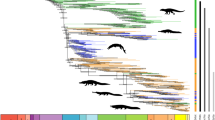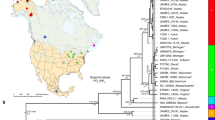Abstract
THE classical hypothesis for the diversification of birds and mammals proposes that most of the orders diverged rapidly in adaptive radiations after the Cretaceous/Tertiary (K/T) extinction event 65 million years ago1–3. Evidence is provided by the near-absence of fossils representing modern orders before the K/T boundary4,5. However, fossil-based estimates of divergence time are known to be conservative because of sampling biases6, and some molecular/time estimates point to earlier divergences among orders7–10. In an attempt to resolve this controversy, we have estimated times of divergence among avian and mammalian orders with a comprehensive set of genes that exhibit a constant rate of substitution. Here we report molecular estimates of divergence times that average about 50–90% earlier than those predicted by the classical hypothesis, and show that the timing of these divergences coincides with the Mesozoic fragmentation of emergent land areas. This suggests that continental breakup may have been an important mechanism in the ordinal diversification of birds and mammals.
This is a preview of subscription content, access via your institution
Access options
Subscribe to this journal
Receive 51 print issues and online access
$199.00 per year
only $3.90 per issue
Buy this article
- Purchase on Springer Link
- Instant access to full article PDF
Prices may be subject to local taxes which are calculated during checkout
Similar content being viewed by others
References
Romer, A. S. Vertebrate Paleontology (Univ. Chicago Press, 1966).
Strickberger, M. W. Evolution (Jones and Bartlett, Boston, MA, 1995).
Feduccia, A. Science 267, 637–638 (1995).
Benton, M. J. (ed.) The Fossil Record Vol. 2 (Chapman and Hall, New York, 1993).
Chiappe, L. M. Nature 378, 349–355 (1995).
Martin, R. D. Nature 363, 223–234 (1993).
Prager, E. M., Brush, A. H., Nolan, R. A., Nakanishi, M. & Wilson, A. C. J. molec. Evol. 3, 243–262 (1974).
Li, W.-H., Gouy, M., Sharp, P. M., O'Huigin, C. & Yang, Y.-W. Proc. natn. Acad. Sci. U.S.A. 87, 6703–6707 (1990).
Easteal, S., Collet, C. & Betty, D. The Mammalian Molecular Clock (Landes, Austin, TX, 1995).
Janke, A., Feldmaier-Fuchs, G., Thomas, W. K., von Haeseler, A. & Pääbo, S. Genetics 137, 243–256 (1994).
Smithson, T. R. Nature 342, 676–678 (1989).
Ahlberg, P. E. & Milner, A. R. Nature 368, 507–514 (1994).
Hallam, A. An Outline of Phanerozoic Biogeography (Oxford Univ. Press, 1994).
Padian, K. & Clemens, W. A. in Phanerozoic Diversity Patterns (ed. Valentine, J. W.) 41–96 (Princeton Univ. Press, NJ, 1985).
Zug, G. R. Herpetology (Academic, San Diego, CA, 1993).
Russell, D. A. Hist Biol. 10, 3–12 (1995).
Hay, J. M., Ruvinsky, I., Hedges, S. B. & Maxson, L. R. Molec. Biol. Evol. 12, 928–937 (1995).
Duret, L., Mouehiroud, D. & Gouy, M. Nucleic Acids Res. 22, 2360–2365 (1994).
Novacek, M. Nature 356, 121–125 (1992).
Higgins, D. G., Bleasby, A. J. & Fuchs, R. Comput. Appl. Biosci. 8, 189–191 (1992).
Kumar, S., Tamura, K. & Nei, M. Molecular Evolutionary Genetics Analysis version 1.01 (Pennsylvania State University, 1993).
Tajima, F. Genetics 135, 599–607 (1993).
Ota, T. & Nei, M. J. molec. Evol. 38, 642–643 (1994).
Ramirez, V., Savoie, P. & Morais, R. J. molec. Evol. 37, 296–310 (1993).
Xu, X. & Àrnason, U. Gene 148, 357–362 (1994).
Takezaki, N., Rzhetsky, A. & Nei, M. Molec. Biol. Evol. 12, 823–833 (1995).
Hedges, S. B. & Sibley, C. G. Proc. natn. Acad. Sci. U.S.A. 91, 9861–9865 (1994).
Felsenstein, J. Phylogenetic Inference Package (PHYLIP) Version 3.5, (University of Washington, Seattle, 1993).
Sibley, C. & Ahlquist, J. Phylogeny and Classification of Birds (Yale Univ. Press, New Haven, CT, 1990).
Smith, A. G., Smith, D. G. & Funnell, B. M. Atlas of Mesozoic and Cenozoic Coastlines (Cambridge Univ. Press, 1994).
Author information
Authors and Affiliations
Rights and permissions
About this article
Cite this article
Hedges, S., Parker, P., Sibley, C. et al. Continental breakup and the ordinal diversification of birds and mammals. Nature 381, 226–229 (1996). https://doi.org/10.1038/381226a0
Received:
Accepted:
Issue Date:
DOI: https://doi.org/10.1038/381226a0
Comments
By submitting a comment you agree to abide by our Terms and Community Guidelines. If you find something abusive or that does not comply with our terms or guidelines please flag it as inappropriate.



